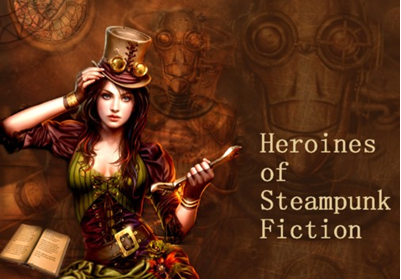Steampunk and the Heroine’s Journey: Introduction
The surprising impact of Steampunk novels on The Heroine’s Journey
A series by Mary Sheridan
INTRODUCTION
It is the visual images of Steampunk that first grab our attention, but the fantastical nature of its fiction invites us to step into the parlor for tea with the storytellers.
What is Steampunk, you ask?
 Magic and illusion intertwined with reality; history bending to imagination. Science abused by impossible theories to create implausible yet ingenious contraptions, and readers willing to suspend all logic, because in the fantasy worlds of Steampunk a popular historical paradigm is in play. Authors and readers feel a sense that what appears improbable might actually be possible.
Magic and illusion intertwined with reality; history bending to imagination. Science abused by impossible theories to create implausible yet ingenious contraptions, and readers willing to suspend all logic, because in the fantasy worlds of Steampunk a popular historical paradigm is in play. Authors and readers feel a sense that what appears improbable might actually be possible.
If you haven’t read Steampunk and are wondering what to expect, the following paragraphs are a mash-up of themes; a contrived sampling of a few sights and sounds not quoted from specific novels but imagined for this Fangirl series as a glimpse at Steampunk’s fictional range. As preposterous as this compilation of complexities may seem, similar individual elements can be found in most Steampunk novels.
Something mysterious, or worse, follows a familiar-looking man into the swirling fog that hangs in the dark and empty streets of old London. A pack of dogs wail in the near distance. Beneath a gaslight, the shadow of a tall figure turns a cloaked arm in his direction. Icy fear raises hairs on flesh that glows orange as the flamethrower approaches. The man with a familiar face does not hear Big Ben ring the midnight hour.
The next morning, two Victorian ladies stand over a crumpled form as they investigate the latest in a string of grisly murders. Both women are visibly armed with ornate pistols tucked into their leather corsets. Two men wearing goggles with multi-layered magnifying lenses take little notice as they ride past on steam-powered bicycles. Overhead, an elaborate airship carries excited passengers to dangerous adventures in exotic lands.
You, the reader, suddenly envision yourself working beside your old friend Hemingway. You put the finishing touches on the gleaming wood planks and brass fittings of a hand-built, steam-powered boat, and eagerly set sail for the edge of the Earth. There you find Captain Nemo cursing the Nautilus, now dead in the water. The three of you design and build a vapor drum inducer which forms a permanent cylinder of spinning seawater around the crippled boat. Its constant motion should propel the sub in fine fashion, but Nemo is concerned about the rising hull temperature. When no one is looking, Hemingway’s feisty nautimech automaton rolls down a ramp into Nautilus and modifies the engine, solving the problem by adding a vaporcollector that draws steam from the superheated water and converts it to fuel. Suddenly, Nautilus lurches upward under an unexpected boost in pressure from the new propulsion system. It breaks away from its ocean home and heads for new adventures in space. Soon Hemingway abandons you to Nemo’s company, mumbling about a story he must write.
In light of this short sample, you may not be surprised to learn that Steampunk consistently defies description.
If you ask ten Steampunks to describe their favorite genre, aside from a few common elements you will probably hear ten different answers. This is easily verified through a quick search of internet Steampunk articles and chats, but it was also the result achieved when Mad Hatter’s Bookshelf and Book Review performed just such a survey in 2010.
Further complicating matters is the accelerated expansion of the modern Steampunk community. What began a century ago as a stylish writing genre is now only one part of a vast alternative culture. However, as interesting as that extended Steampunk community is, we will only touch upon it in this series. Our focus is on the genre’s fiction: its influences and development into a force that impacts a wide variety of arts and media.
We will work our way toward the series’ center stage, reserved for the growing number of successful women Steampunk authors, their ideas and clear objective to build a contemporary heroic model for strong, realistic, memorable female characters.
Although not perhaps an obvious choice, Steampunk may in fact be an excellent vehicle to carry women toward a new Heroine’s Journey model. Certainly, Victorian corsets and manners don’t appear to be slowing them down.
Please join us as we at Fangirl buckle into our adventuring clothes, retrieve our goggles, and step into a larger world.
In this series, Mary explores several aspects of Steampunk, leading up to the challenges that the genre’s fiction presents to Joseph Campbell’s Hero’s Journey monomyth. Central to the discussion is the expanding group of female Steampunk authors working to create a feminine model to parallel Campbell’s masculine myth.
Part One sets the stage by considering the surprisingly difficult question, “What is Steampunk?”
Mary Sheridan is a former ER and Trauma nurse with a life-long passion for real and imagined adventure – usually on horseback. Her right-brain enjoys fangirling over genre books and films; her left brain has finally given up trying to bring order to that chaos. Star Wars has been her favorite alternate reality since 1977 but she also enjoys Star Trek, The Hunger Games – most things creative and adventurous. Recently she has grown suspicious that a subliminal indoctrination process was initiated during her early years by a nefarious group of time-traveling operatives in Queen Victoria’s most Secret Service. While researching this series, Mary felt a sudden compulsion to join her local Steampunk Society and spends large amounts of time seeking period costume pieces – evidence of a latent desire to identify herself as a Steampunk. She is being monitored for disorientation since declaring that once she finds the perfect pair of brass goggles, she hopes to go back to the retro-future in a steam-powered DeLorean.
- Oscars: Free Us Or Die - February 23, 2015
- SAGA Read Along: Inspiring Characters - February 7, 2015
- Is There A Star Wars Gene? - January 13, 2015










